Stockman (Australia) on:
[Wikipedia]
[Google]
[Amazon]
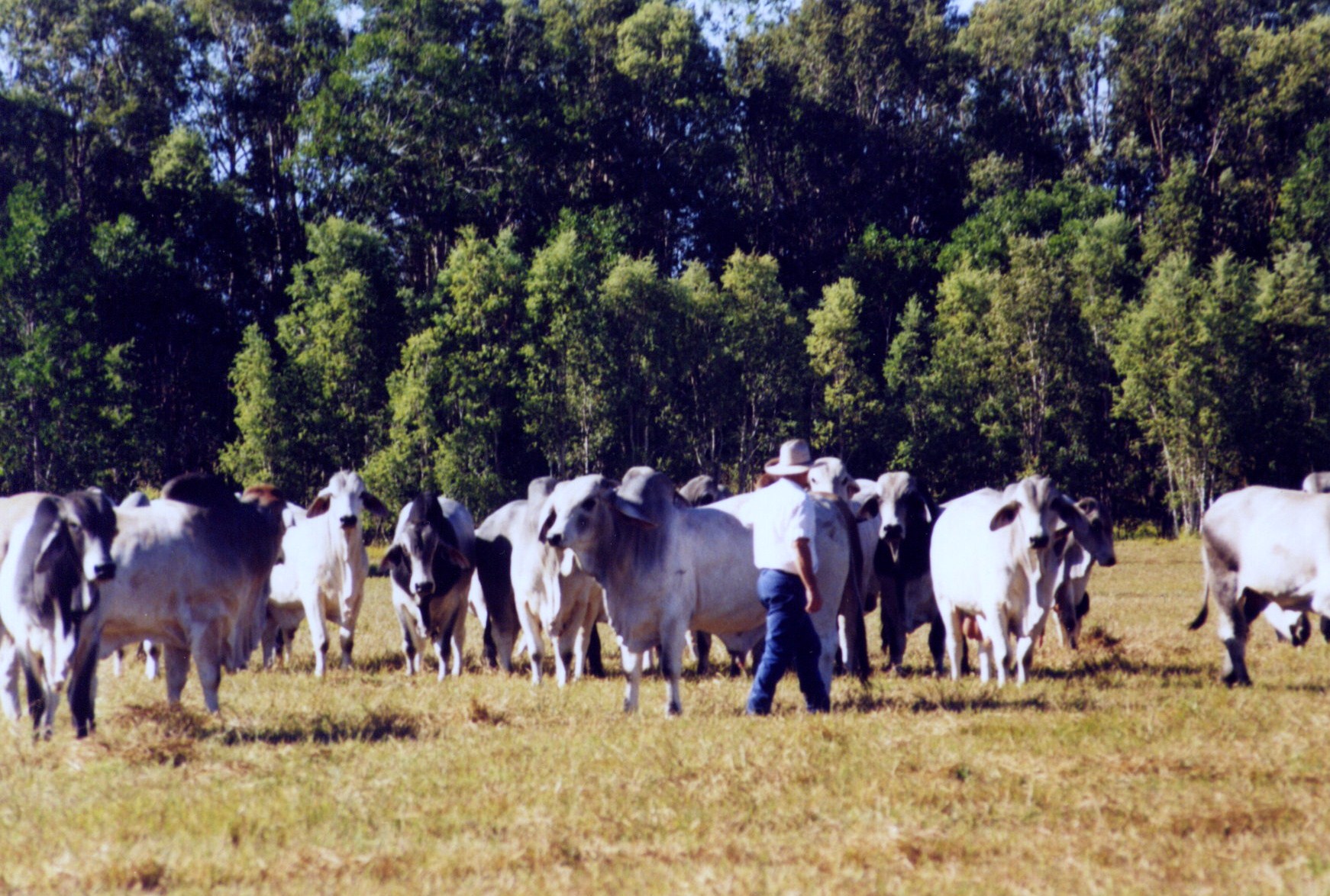
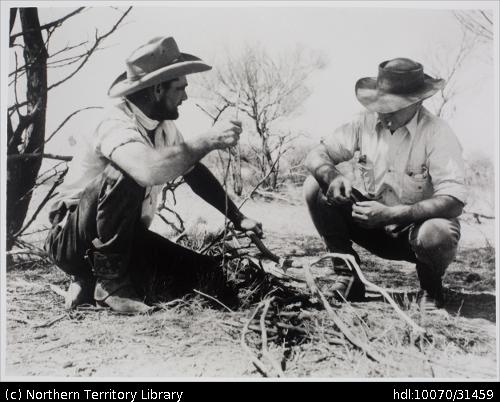
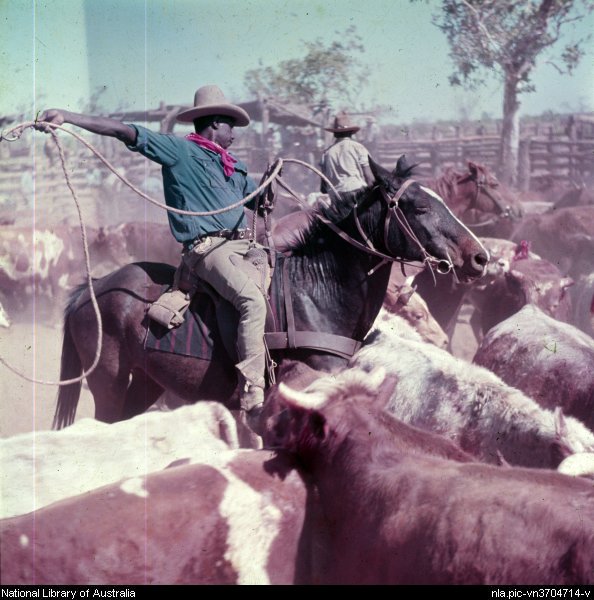
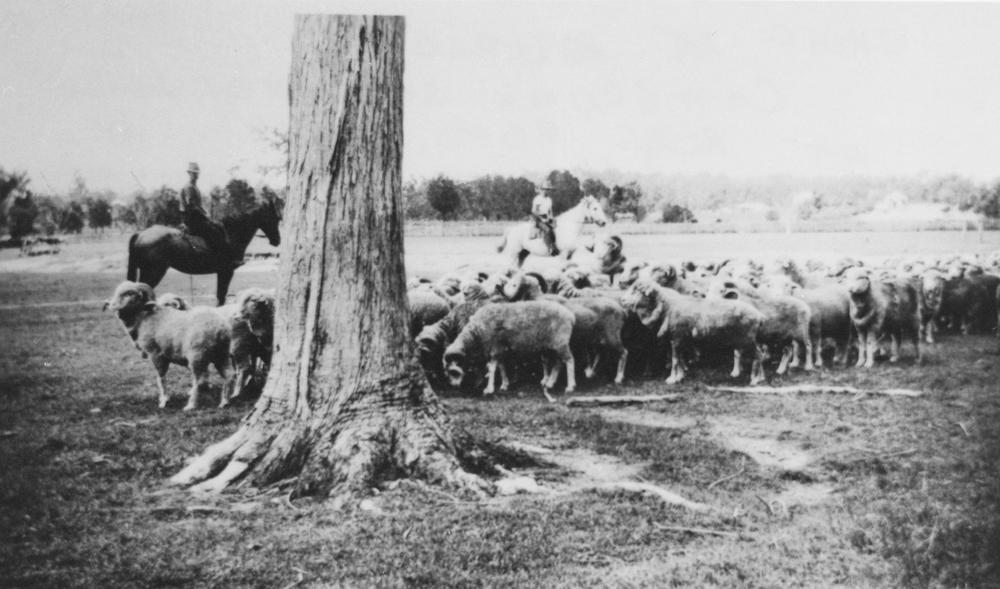
 In Australia a stockman (plural stockmen) is a person who looks after the
In Australia a stockman (plural stockmen) is a person who looks after the

 The role of the mounted stockmen came into being early in the 19th century, when in 1813 the Blue Mountains separating the coastal plain of the Sydney region from the interior of the continent was crossed. The town of Bathurst was founded shortly after, and potential farmers moved westward, and settled on the land, many of them as squatters. The rolling country, ideal for sheep and the large, often unfenced, properties necessitated the role of the
The role of the mounted stockmen came into being early in the 19th century, when in 1813 the Blue Mountains separating the coastal plain of the Sydney region from the interior of the continent was crossed. The town of Bathurst was founded shortly after, and potential farmers moved westward, and settled on the land, many of them as squatters. The rolling country, ideal for sheep and the large, often unfenced, properties necessitated the role of the
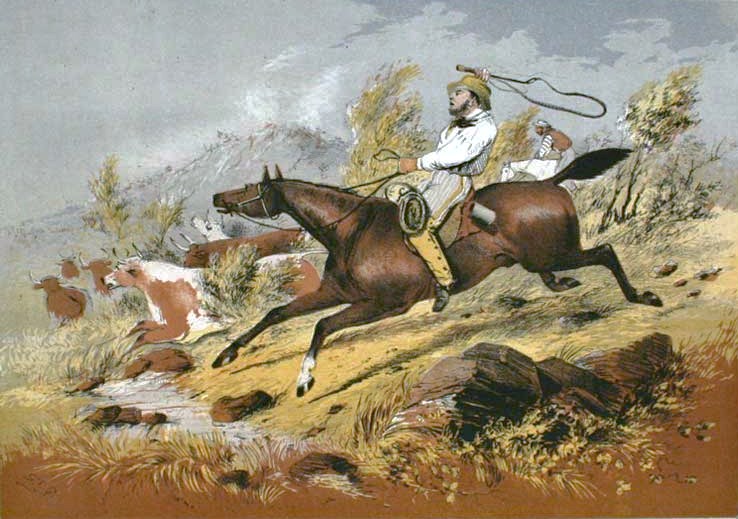
 The role of the stockmen has often been celebrated in various media, with the stockman being generally more highly renowned for his ability to bring down a bullock than an
The role of the stockmen has often been celebrated in various media, with the stockman being generally more highly renowned for his ability to bring down a bullock than an
 * Nathaniel Buchanan
* Ben Hall (9 May 1837 – 5 May 1865)
* Sidney Kidman
*
* Nathaniel Buchanan
* Ben Hall (9 May 1837 – 5 May 1865)
* Sidney Kidman
*
Stockman mustering cattle — photo
—
King on the Ranges
— includes Stockman mustering horses
Australian Stockman's Hall of Fame
— official website
— Queensland Government website {{Mounted stock herders Animal husbandry occupations Horse-related professions and professionals Australian English Australian folklore Livestock in Australia




 In Australia a stockman (plural stockmen) is a person who looks after the
In Australia a stockman (plural stockmen) is a person who looks after the livestock
Livestock are the domesticated animals raised in an agricultural setting to provide labor and produce diversified products for consumption such as meat, eggs, milk, fur, leather, and wool. The term is sometimes used to refer solely to ani ...
on a large property known as a station, which is owned by a grazier or a grazing company, traditionally on horseback. In this sense it has a similar meaning to "cowboy
A cowboy is an animal herder who tends cattle on ranches in North America, traditionally on horseback, and often performs a multitude of other ranch-related tasks. The historic American cowboy of the late 19th century arose from the '' vaqu ...
". A stockman may also be employed at an abattoir
A slaughterhouse, also called abattoir (), is a facility where animals are slaughtered to provide food. Slaughterhouses supply meat, which then becomes the responsibility of a packaging facility.
Slaughterhouses that produce meat that is no ...
, feedlot
A feedlot or feed yard is a type of animal feeding operation (AFO) which is used in intensive animal farming, notably beef cattle, but also swine, horses, sheep, turkeys, chickens or ducks, prior to slaughter. Large beef feedlots are called c ...
, on a livestock export ship, or with a stock and station agency.
Associated terms
Stockmen who work with the cattle in theTop End
The Top End of Australia's Northern Territory is a geographical region encompassing the northernmost section of the Northern Territory, which aside from the Cape York Peninsula is the northernmost part of the Australian continent. It covers a ra ...
are known as ringers and are often only employed for the dry season
The dry season is a yearly period of low rainfall, especially in the tropics. The weather in the tropics is dominated by the tropical rain belt, which moves from the northern to the southern tropics and back over the course of the year. The ...
which lasts from April to October. A station hand is an employee who is involved in routine duties on a rural property or station, which may also involve caring for livestock. With pastoral properties facing dire recruitment problems as young men are lured into the booming mining industry, young women from the cities are becoming a common sight on outback stations, often attracted by the chance to work with horses. An associated occupation is that of the drover, who, like the shearer may be an itinerant worker, and is employed in tending to livestock while they are travelling on a stock route.
A station trainee is known as a jackaroo (male) or jillaroo (female).
History

shepherd
A shepherd or sheepherder is a person who tends, herds, feeds, or guards flocks of sheep. ''Shepherd'' derives from Old English ''sceaphierde (''sceap'' 'sheep' + ''hierde'' ' herder'). ''Shepherding is one of the world's oldest occupations, ...
to tend the flocks.
Early stockmen were specially selected, highly regarded men owing to the high value and importance of early livestock. All stockmen need to be interested in animals, able to handle them with confidence and patience, able to make accurate observations about them and enjoy working outdoors.
Aboriginal Australian
Aboriginal Australians are the various Indigenous peoples of the Australian mainland and many of its islands, such as Tasmania, Fraser Island, Hinchinbrook Island, the Tiwi Islands, and Groote Eylandt, but excluding the Torres Strait I ...
s were good stockmen who played a large part in the successful running of many stations. With their intimate bonds to their tribal places, and local knowledge they also took considerable pride in their work. After the gold rushes white labour was expensive and difficult to retain. Aboriginal women also worked with cattle on the northern stations after this practice developed in northern Queensland
)
, nickname = Sunshine State
, image_map = Queensland in Australia.svg
, map_caption = Location of Queensland in Australia
, subdivision_type = Country
, subdivision_name = Australia
, established_title = Before federation
, establishe ...
during the 1880s. A Native Administration Act later stopped the employment of women in the cattle camps. Aboriginal people often received only food and clothing to retain their labour, until they began to be paid a small cash wage in the 1950s and 1960s, much less than their white counterparts. In 1966, Vincent Lingiari
Vincent Lingiari (13 June 1908 or 1919 – 21 January 1988) was an Australian Aboriginal rights activist and member of the Gurindji people. In his early life he started as a stockman at Wave Hill Station, where the Aboriginal workers were g ...
led Gurindji workers on the Wave Hill walk-off, a strike on the large Vesteys
Vestey Holdings, formerly Vestey Group and previously also known as Vestey Brothers, is a privately-owned UK group of companies comprising an international business focused mainly on food products and services. The company has owned vast holdin ...
cattle station in the Northern Territory
The Northern Territory (commonly abbreviated as NT; formally the Northern Territory of Australia) is an Australian territory in the central and central northern regions of Australia. The Northern Territory shares its borders with Western Aust ...
, which brought about wage parity two years later. In the 21st century class action
A class action, also known as a class-action lawsuit, class suit, or representative action, is a type of lawsuit where one of the parties is a group of people who are represented collectively by a member or members of that group. The class actio ...
s for these " stolen wages", as they have been dubbed, have taken place in Queensland, Western Australia
Western Australia (commonly abbreviated as WA) is a state of Australia occupying the western percent of the land area of Australia excluding external territories. It is bounded by the Indian Ocean to the north and west, the Southern Ocean to t ...
and the NT.
In 1911, rural stockmen received only £1 to £1/5/- a week plus keep after a decision was made by the Arbitration Court. The award of 1918 increased wages by up to 50 per cent to a minimum of £2/13/-. Head stockmen received about £1 extra. Stockmen now work under a state or federal award, which is reviewed regularly.
Role and description
A stockman is responsible for the care for livestock and treatment of their injuries and illnesses. This includes feeding, watering,mustering
Muster may refer to:
Military terminology
* Muster (military), a process or event for the accounting for members in a military unit
* Muster list, list of the functions for team members
* A mustering, in military terminology, is a specialised for ...
, droving, branding, castrating, ear tag
An ear tag is a plastic or metal object used for identification of domestic livestock and other animals. If the ear tag uses Radio Frequency Identification Device ( RFID) technology it is referred to as an electronic ear tag. Electronic ear t ...
ging, weighing, vaccinating livestock and dealing with their predators. Stockmen need to be able to judge age by examining the dentition (teeth) of cattle, sheep and occasionally horses. Those caring for sheep will regularly have to deal with flystrike treatments, jetting animals, worm control and lamb marking. Pregnant livestock usually receive special care in late pregnancy and stockmen may have to deal with dystocia
Obstructed labour, also known as labour dystocia, is the baby not exiting the pelvis because it is physically block during childbirth although the uterus contracts normally. Complications for the baby include not getting enough oxygen which may ...
(abnormal or difficult birth or labour). A good stockman is aware of livestock behavioural characteristics, and has an awareness of flight zone distances of the livestock being handled. Apart from livestock duties a stock person will inspect, maintain and repair fences, gates and yards that have been broken by storms, fallen trees, livestock and wildlife.
A head stockman is responsible for a number of workers and a range of livestock and property operations including the supervision of operations that includes feeding, mating, managing artificial breeding and embryo transfer programs; managing vehicle and equipment maintenance; repair and maintenance of property structures; supervising and training of staff.
Mustering is done with horses or vehicles including all-terrain vehicle
An all-terrain vehicle (ATV), also known as a light utility vehicle (LUV), a quad bike, or simply a quad, as defined by the American National Standards Institute (ANSI); is a vehicle that travels on low-pressure tires, with a seat that is stra ...
s (ATV), and some of the large cattle stations use helicopter
A helicopter is a type of rotorcraft in which lift and thrust are supplied by horizontally spinning rotors. This allows the helicopter to take off and land vertically, to hover, and to fly forward, backward and laterally. These attribu ...
s or light aircraft to assist in the mustering and surveillance of livestock and their watering points. Cattle mustering in the Outback
The Outback is a remote, vast, sparsely populated area of Australia. The Outback is more remote than the bush. While often envisaged as being arid, the Outback regions extend from the northern to southern Australian coastlines and encompass a ...
and the eastern ‘Falls’ country of the Great Dividing Range
The Great Dividing Range, also known as the East Australian Cordillera or the Eastern Highlands, is a cordillera system in eastern Australia consisting of an expansive collection of mountain ranges, plateaus and rolling hills, that runs rough ...
often necessitates days camping out in isolated areas and sleeping in a swag (bedroll) on the ground with limited food choices. Damper is a traditional type of bread that was baked by stockmen during colonial times, or nowadays when the bread supply has been exhausted. It is made with self-raising flour, salt and water and is usually cooked in a camp oven over the embers of a fire. In these areas the days in the saddle are often very long as the cattle have to be mustered and then driven to yards or a paddock where they can be held. After the stock have been yarded they may then require drafting prior to branding, shearing or whatever procedures are required or have been planned.Coupe, Sheena (gen. ed.), ''Frontier Country, Vol. 1'', Weldon Russell Publishing, Willoughby, 1989,
The employment of mounted workers to tend livestock is necessitated in Australia by the large size of the "properties" which may be called sheep stations or cattle stations, depending upon the type of stock. In the inland regions of most states excluding Victoria and Tasmania, cattle stations may exceed 10,000 km² with the largest being Anna Creek Station at 24,000 km² (6,000,000 acres).
The traditional attire of a stockman or grazier is a felt Akubra
Akubra is an Australian hat manufacturer. The company is associated with bush hats made of rabbit fur felt with wide brims that are worn in rural Australia. The term "Akubra" is sometimes used to refer to any hat of this kind, however the compa ...
hat; a double-flapped, two-pocket (for stock notebooks) cotton shirt; a plaited Kangaroo leather belt carrying a stockman's pocket knife in a pouch; light coloured, stockman cut, moleskin trousers with brown elastic side boots. The moleskin trousers have now largely been replaced by jeans. The plaited belt is often replaced by a working stockman or ringer with a belt known as a Queensland Utility Strap which can be used as a belt, neck strap, lunch-time hobble or a tie for a "micky". This attire is still used in Australian Stock Horse competitions. Pocket knives may be used to castrate and/or earmark an animal, to bang cattle tails or in an emergency to cut free an animal entangled in a rope or horse tack. Specially designed and cut for riding, oilskin
Oilskin is a waterproof cloth used for making garments typically worn by sailors and by others in wet areas. The modern oilskin garment was developed by a New Zealander, Edward Le Roy, in 1898. Le Roy used worn-out sailcloth painted with a mixt ...
Driza-Bone coats are used during wet weather. The horse typically wears a ringhead bridle, a saddle cloth, a leather Australian stock saddle, which may be equipped with a breastplate in steep country, and saddlebag and quart-pot.
Changing times
Stockmen traditionally ridehorse
The horse (''Equus ferus caballus'') is a domesticated, one-toed, hoofed mammal. It belongs to the taxonomic family Equidae and is one of two extant subspecies of ''Equus ferus''. The horse has evolved over the past 45 to 55 million yea ...
s, use working dogs and a stockwhip for stock work and mustering
Muster may refer to:
Military terminology
* Muster (military), a process or event for the accounting for members in a military unit
* Muster list, list of the functions for team members
* A mustering, in military terminology, is a specialised for ...
, but motorised vehicle
A vehicle (from la, vehiculum) is a machine that transports people or cargo. Vehicles include wagons, bicycles, motor vehicles (motorcycles, cars, trucks, buses, mobility scooters for disabled people), railed vehicles (trains, trams), ...
s are increasingly used. Sometimes the vehicles that are used are four-wheel drive
Four-wheel drive, also called 4×4 ("four by four") or 4WD, refers to a two-axled vehicle drivetrain capable of providing torque to all of its wheels simultaneously. It may be full-time or on-demand, and is typically linked via a transfer ca ...
(4WD) "paddock-bashers", which are often old unregistered utilities. These vehicles may also be modified by removing the top and fitting roll and bull bars for bull or buffalo catching.
Some stations are now making changes for the employment of women by building female living quarters and installing hydraulic cattle crushes etc.
Transportable steel yards are now often carried on a truck to an area where stock-work can be completed without having to drive stock long distances to permanent yards. Stockmen and their horses can be unloaded at these yards and then the cattle can be branded and also transported from these yards if required. Lambs are also often marked in temporary yards as a means of reducing infection.
Sports
A number of equestrian sports are particularly associated with stockmen. These includecampdrafting
Campdrafting is a unique Australian sport involving a horse and rider working cattle. The riding style is Australian stock, somewhat akin to American Western riding and the event is similar to the American stock horse events such as cutting, ...
, team penning, tentpegging and polocrosse
Polocrosse is a team sport that is a combination of polo and lacrosse. It is played outside, on a field (the pitch), on horseback. Each rider uses a cane or fibreglass stick to which is attached a racquet head with a loose, thread net, in whi ...
, as well as working dog trials. The sports are played in local and state competitions and are often a feature of agricultural shows such as the Sydney Royal Easter Show
First held in 1823, the Sydney Royal Easter Show, commonly shortened to The Easter Show or The Show, is an annual show held in Sydney, Australia over two weeks around the Easter period. It comprises an agricultural show, an amusement park and a ...
. Stockman challenges are also gaining in popularity across the eastern states of Australia. In this event competitors show their skills by whipcracking, packing a packhorse
A packhorse, pack horse, or sumpter refers to a horse, mule, donkey, or pony used to carry goods on its back, usually in sidebags or panniers. Typically packhorses are used to cross difficult terrain, where the absence of roads prevents the use of ...
(to be led around a course), bareback obstacle course, cross country, shoeing and stock handling competing in a single Australian Stock Saddle. The best will compete in a final with a brumby catch and a second final section of a stock saddle buckjump ride where they have to mark out carrying a stockwhip, or a timed obstacle event.
Cultural depictions of stockmen

 The role of the stockmen has often been celebrated in various media, with the stockman being generally more highly renowned for his ability to bring down a bullock than an
The role of the stockmen has often been celebrated in various media, with the stockman being generally more highly renowned for his ability to bring down a bullock than an outlaw
An outlaw, in its original and legal meaning, is a person declared as outside the protection of the law. In pre-modern societies, all legal protection was withdrawn from the criminal, so that anyone was legally empowered to persecute or kill th ...
and for sharp wit rather than sharp shooting.
Two well-known songs commemorate the death of a stockman, the anonymous "Wrap me up with my stockwhip and blanket" and Rolf Harris's " Tie Me Kangaroo Down, Sport".
Through the 19th and early 20th centuries the writing of ballad
A ballad is a form of verse, often a narrative set to music. Ballads derive from the medieval French ''chanson balladée'' or '' ballade'', which were originally "dance songs". Ballads were particularly characteristic of the popular poetry and ...
ic poetry was a favoured form of literary expression, and the public recitation of such pieces remains a feature of Australian folk festival
A folk festival celebrates traditional folk crafts and folk music. This list includes folk festivals worldwide, except those with only a partial focus on folk music or arts. Folk festivals may also feature folk dance or ethnic foods.
Handicra ...
s. The majority of the most popular ballads deal with rural subject and many are specifically about stockmen. These works include Adam Lindsay Gordon's '' Bush Ballads and Galloping Rhymes'' which includes " The Sick Stockrider", and, most famously, Banjo Paterson's epic poem '' The Man from Snowy River''.
"The Man from Snowy River" was to become the source of three movies, one in 1920, and another in 1982 to be followed by a sequel. A TV series followed called '' Banjo Paterson's The Man from Snowy River''.
In 2002 the story was shown as live musical theatre called '' The Man from Snowy River: Arena Spectacular''. The inspiration for this musical performance came from the Opening Ceremony of the 2000 Summer Olympics
The 2000 Summer Olympics, officially the Games of the XXVII Olympiad and also known as Sydney 2000 ( Dharug: ''Gadigal 2000''), the Millennium Olympic Games or the Games of the New Millennium, was an international multi-sport event held from ...
in Sydney, when the performance opened with 121 stockmen and women riding Australian Stock Horses in a tribute to the Australian pastoral heritage and the importance of the stock horse in Australia's heritage.Commentary on the official DVD of the opening ceremony of the 2000 Summer Olympics The pastoral tribute took place to music written by Bruce Rowland
Bruce Rowland (born 9 May 1942 in Melbourne) is an Australian composer.
Biography
Rowland composed the soundtrack for the 1982 movie '' The Man from Snowy River'', as well as the soundtrack for its 1988 sequel '' The Man from Snowy River II' ...
, who composed a special Olympics version of the main theme for the 1982 movie "'' The Man from Snowy River''". David Atkins
David Atkins, OAM (born 12 December 1955) is an Australian dancer, choreographer, music-theatre director and producer.
Career
Stage and television
Atkins began his performance career aged 12 with a role in the musical ''Mame''. As an adult p ...
and Ignatius Jones, who were the artistic creators of the opening ceremony of the 2000 Summer Olympics in Sydney, were also the co-creators of the musical, '' The Man from Snowy River: Arena Spectacular''.
A further tribute to the stockman derives from the fact that for a number of years the promotions of the Sydney Royal Easter Show
First held in 1823, the Sydney Royal Easter Show, commonly shortened to The Easter Show or The Show, is an annual show held in Sydney, Australia over two weeks around the Easter period. It comprises an agricultural show, an amusement park and a ...
have referred to it as "The Great Australian Muster".
In Longreach, Queensland, a museum and memorial called the Australian Stockman's Hall of Fame was established to pay tribute to the pioneers of the Australian outback.
Famous stockmen
 * Nathaniel Buchanan
* Ben Hall (9 May 1837 – 5 May 1865)
* Sidney Kidman
*
* Nathaniel Buchanan
* Ben Hall (9 May 1837 – 5 May 1865)
* Sidney Kidman
* William Henry Ogilvie
Will H. Ogilvie (21 August 1869 – 30 January 1963) was a Scottish-Australian narrative poet and horseman, jackaroo, and drover, and described as a quiet-spoken handsome Scot of medium height, with a fair moustache and red complexion. He ...
* James Alpin McPherson
James Alpin MacPherson (1842–23 August 1895) otherwise known as The Wild Scotchman, was a Scottish–born Australian bushranger active in Queensland and New South Wales in the 1860s. He was operational throughout the greater Wide Bay area ...
* Breaker Morant
See also
*Animal husbandry
Animal husbandry is the branch of agriculture concerned with animals that are raised for meat, fibre, milk, or other products. It includes day-to-day care, selective breeding, and the raising of livestock. Husbandry has a long history, starti ...
* Drover (Australian)
* Stockman (disambiguation)
References
External links
Stockman mustering cattle — photo
—
CSIRO
The Commonwealth Scientific and Industrial Research Organisation (CSIRO) is an Australian Government agency responsible for scientific research.
CSIRO works with leading organisations around the world. From its headquarters in Canberra, CSIRO ...
website
King on the Ranges
— includes Stockman mustering horses
Australian Stockman's Hall of Fame
— official website
— Queensland Government website {{Mounted stock herders Animal husbandry occupations Horse-related professions and professionals Australian English Australian folklore Livestock in Australia